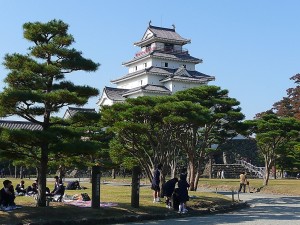Fukushima Prefecture in the Tohoku region, the north east of Japan, is by size the third largest local government area at prefecture level. After the 2011 Great East Japan Earthquake, and in addition to the accident at the nuclear power station, the word Fukushima is a name that has become familiar to many people around the world. Six years after the earthquake, the prefectural government is currently engaging in a variety of public information initiatives about the current situation in the region, as well as promoting its attractions and current local government initiatives, in order to update the world’s image of ‘Fukushima’.
Fukushima is located approximately in the centre of the East of Japan region, has the same area and population size and Northern Ireland, and it separated by mountains into three regions: West side, the historical, traditional and beautiful rural area of Aizu; Central Nakadori, the economic heart and blessed with bountiful fruit and vegetable produce; East side, Hamadori area facing the Pacific Ocean has a warm and comfortable climate.
Lake Inawashiro, Japan’s fourth-largest lake, and Mount Bandai which is the symbol of the prefecture are in the centre of the region.
While being only an hour and a half by shinkansen, (or ‘bullet train’) to the north, the well-known attractions include being able to enjoy spending time relaxing in the Japanese countryside surrounded by lush green mountains and beautiful waterside vistas, where visitors are able to sample the delicious speciality produce of the region and Japanese sake using local fruit.
This year the prefecture is working on a special skiing campaign aimed at visitors from overseas and is hoping to attract those looking for Japan’s famous powder snow slopes to the area, which can be seen on the following pages:
Fukushima Prefecture Travel Information
2017-2018 Ski Fukushima Campaign
The Nuclear Plant Accident and the Current Situation
The TEPCO (Tokyo Electric Power Company) Fukushima Daiichi Nuclear Power Plant, the site of the accident, is on Fukushima Prefecture’s east coast on the Pacific Ocean side of Japan. The work to clean up the remaining fuel in the facility and towards decommission the power plant continues today. Some think the level of radiation in Fukushima Prefecture is high, but currently only three percent of the total area of the region, the area immediately surrounding the power plant is a controlled no-entry area.
All produce in Fukushima Prefecture, including the staple of the Japanese diet rice, is measured for radioactive caesium before being shipped. For other agricultural products, to ensure their safety preliminary inspections of major staples and are made before items are distributed as well as random sample inspections.
After the experiences of the earthquake, as well as the tsunami and power station accident, the area along the coast will see the building of an industry cluster around decommissioning technology, future disaster countermeasures and next-generation energy, where R&D bases will promote joint international industry-academia-government cooperation at facilities starting with a ‘robotics test field’. In the field of next-generation energy, a floating wind turbine will be tested off the coast of Fukushima, with further plans for hydrogen energy demonstration tests to follow.
Fukushima Prefecture Revitalisation public information
Fukushima Innovation Coast Framework portal
The Guardian‘s Jane Dudman visited Iwaki in the south of Fukushima Prefecture, and wrote the following articles on community resilience:
After Fukushima: the tenants rebuilding a destroyed community
Japan’s post-tsunami recovery plan: tomatoes, fish and hula-dancing
Aizu-Wakamatsu Castle photo by courtesy of lienyuan lee, licensed under the Creative Commons Attribution 3.0 Unported license.


